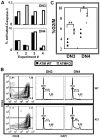ATM influences the efficiency of TCRβ rearrangement, subsequent TCRβ-dependent T cell development, and generation of the pre-selection TCRβ CDR3 repertoire
- PMID: 23626787
- PMCID: PMC3633875
- DOI: 10.1371/journal.pone.0062188
ATM influences the efficiency of TCRβ rearrangement, subsequent TCRβ-dependent T cell development, and generation of the pre-selection TCRβ CDR3 repertoire
Abstract
Generation and resolution of DNA double-strand breaks is required to assemble antigen-specific receptors from the genes encoding V, D, and J gene segments during recombination. The present report investigates the requirement for ataxia telangiectasia-mutated (ATM) kinase, a component of DNA double-strand break repair, during TCRβ recombination and in subsequent TCRβ-dependent repertoire generation and thymocyte development. CD4(-)CD8(-) double negative stage 2/3 thymocytes from ATM-deficient mice have both an increased frequency of cells with DNA break foci at TCRβ loci and reduced Vβ-DJβ rearrangement. Sequencing of TCRβ complementarity-determining region 3 demonstrates that ATM-deficient CD4(+)CD8(+) double positive thymocytes and peripheral T cells have altered processing of coding ends for both in-frame and out-of-frame TCRβ rearrangements, providing the unique demonstration that ATM deficiency alters the expressed TCRβ repertoire by a selection-independent mechanism. ATMKO thymi exhibit a partial developmental block in DN cells as they negotiate the β-selection checkpoint to become double negative stage 4 and CD4(+)CD8(+) thymocytes, resulting in reduced numbers of CD4(+)CD8(+) cells. Importantly, expression of a rearranged TCRβ transgene substantially reverses this defect in CD4(+)CD8(+) cells, directly linking a requirement for ATM during endogenous TCRβ rearrangement to subsequent TCRβ-dependent stages of development. These results demonstrate that ATM plays an important role in TCRβ rearrangement, generation of the TCRβ CDR3 repertoire, and efficient TCRβ-dependent T cell development.
Conflict of interest statement
Figures






Similar articles
-
ATM deficiency impairs thymocyte maturation because of defective resolution of T cell receptor alpha locus coding end breaks.Proc Natl Acad Sci U S A. 2007 Apr 10;104(15):6323-8. doi: 10.1073/pnas.0611222104. Epub 2007 Apr 3. Proc Natl Acad Sci U S A. 2007. PMID: 17405860 Free PMC article.
-
The requirement for pre-TCR during thymic differentiation enforces a developmental pause that is essential for V-DJβ rearrangement.PLoS One. 2011;6(6):e20639. doi: 10.1371/journal.pone.0020639. Epub 2011 Jun 3. PLoS One. 2011. PMID: 21673984 Free PMC article.
-
The ataxia telangiectasia mutated and cyclin D3 proteins cooperate to help enforce TCRβ and IgH allelic exclusion.J Immunol. 2014 Sep 15;193(6):2881-90. doi: 10.4049/jimmunol.1302201. Epub 2014 Aug 15. J Immunol. 2014. PMID: 25127855 Free PMC article.
-
Differential regulation of proximal and distal Vbeta segments upstream of a functional VDJbeta1 rearrangement upon beta-selection.J Immunol. 2011 Sep 15;187(6):3277-85. doi: 10.4049/jimmunol.1101079. Epub 2011 Aug 15. J Immunol. 2011. PMID: 21844384 Free PMC article.
-
Regulation of T cell receptor (TCR) beta gene expression by CD3 complex signaling in immature thymocytes: implications for TCRbeta allelic exclusion.Proc Natl Acad Sci U S A. 1999 Mar 30;96(7):3882-7. doi: 10.1073/pnas.96.7.3882. Proc Natl Acad Sci U S A. 1999. PMID: 10097132 Free PMC article.
Cited by
-
Regulation of T cell development by c-Cbl: essential role of Lck.Int Immunol. 2015 May;27(5):245-51. doi: 10.1093/intimm/dxu105. Epub 2014 Dec 4. Int Immunol. 2015. PMID: 25477210 Free PMC article.
-
Function and Molecular Mechanism of the DNA Damage Response in Immunity and Cancer Immunotherapy.Front Immunol. 2021 Dec 14;12:797880. doi: 10.3389/fimmu.2021.797880. eCollection 2021. Front Immunol. 2021. PMID: 34970273 Free PMC article. Review.
-
Disturbed B and T cell homeostasis and neogenesis in patients with ataxia telangiectasia.J Clin Immunol. 2014 Jul;34(5):561-72. doi: 10.1007/s10875-014-0044-1. Epub 2014 May 1. J Clin Immunol. 2014. PMID: 24789685
-
A novel mouse model for ataxia-telangiectasia with a N-terminal mutation displays a behavioral defect and a low incidence of lymphoma but no increased oxidative burden.Hum Mol Genet. 2015 Nov 15;24(22):6331-49. doi: 10.1093/hmg/ddv342. Epub 2015 Aug 26. Hum Mol Genet. 2015. PMID: 26310626 Free PMC article.
-
TCR Repertoires of Thymic Conventional and Regulatory T Cells: Identification and Characterization of Both Unique and Shared TCR Sequences.J Immunol. 2020 Feb 15;204(4):858-867. doi: 10.4049/jimmunol.1901006. Epub 2020 Jan 10. J Immunol. 2020. PMID: 31924652 Free PMC article.
References
-
- Hesslein DG, Schatz DG (2001) Factors and forces controlling V(D)J recombination. Adv Immunol 78: 169–232. - PubMed
-
- Fugmann SD, Lee AI, Shockett PE, Villey IJ, Schatz DG (2000) The RAG proteins and V(D)J recombination: complexes, ends, and transposition. Annu Rev Immunol 18: 495–527. - PubMed
-
- Goyarts EC, Vegh Z, Kalergis AM, Horig H, Papadopoulos NJ, et al. (1998) Point mutations in the beta chain CDR3 can alter the T cell receptor recognition pattern on an MHC class I/peptide complex over a broad interface area. Mol Immunol 35: 593–607. - PubMed
-
- Godfrey DI, Kennedy J, Mombaerts P, Tonegawa S, Zlotnik A (1994) Onset of TCR-beta gene rearrangement and role of TCR-beta expression during CD3–CD4–CD8- thymocyte differentiation. J Immunol 152: 4783–4792. - PubMed
Publication types
MeSH terms
Substances
Grants and funding
LinkOut - more resources
Full Text Sources
Other Literature Sources
Molecular Biology Databases
Research Materials
Miscellaneous

